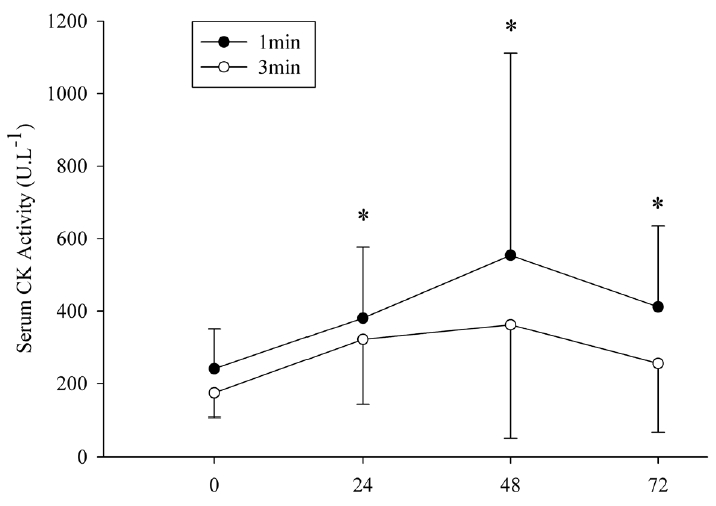INTRODUCTION
Plyometric exercises have been demonstrated to improve power output, agility, and running economy. These exercises use rapid, powerful movements that are preceded by a preloading countermovement activates the stretch-shortening cycle (SSC). The SSC involves the mechanical stretching of muscles and tendons immediately prior to rapid concentric contractions. Mechanisms proposed to contribute to the SSC include the neural potentiation of the contractile machinery during the eccentric phase and reflex contributions from the muscle spindle [1].
Countermovement Jump (CMJ) is a jump that utilizes the stretch-shortening cycle, which is a very eccentric-biased exercise, and the eccentric actions are associated with skeletal muscle tissue damage with sarcolemma disruption and sarcomeric degeneration from Z-disk fragmentation. This fact augments the serum level of skeletal muscle enzymes. Creatine kinase (CK), lactate dehydrogenase (LDH) and myoglobin have been extensively used as markers for muscle micro-damages [2,3,4]. Under such conditions CK serum concentration displays a greater increase than the serum concentration of other muscle proteins. As a result CK is used widely as such a marker of the status of muscle tissue [1,3,5,6].
Plyometric exercises were investigated in many studies [1,7,8,9,10] and the effect of eccentric exercise on muscle damage markers too [3,11], but the effect of SSC on muscle markers serum activity and the effect of rest interval between sets is poorly investigated. Quantifying muscle damage markers in different rest intervals can help coaches and athletes to better prepare the training plan. Therefore, this study aimed to measure the magnitude of variations of serum CK activity after one session of countermovement jump session and compare the serum CK activity between 1 and 3 minutes rest intervals between sets.
METHODS
Thirty non-active subjects, aged 18 to 19 years old, who were neither drug nor nutritional supplement users, participated in a randomized study. The subjects were divided according to a computer-generated randomization list into 1 minute (1-min, n=17) and 3 minutes (3-min, n=13) rest intervals. The subjectŌĆÖs characteristics are displayed in Table 1. The purpose and procedures were explained to the subjects, and informed consent was obtained according to the Declaration of Helsinki, and the institutional Ethics Committee approved the study.
All subjects were submitted to anamnesis, clinical evaluation, anthropometrical measure, and first blood collection on the first day. Anthropometrics including height (to the nearest 0.1 cm), body mass (to the nearest 0.1 kg) were assessed using a calibrated scale (Health O Meter, USA). Then all were submitted a 10 min warm-up (stretching and jogging) and executed 10 sets with 10 maximal countermovement jumps. All the time, the subjects received verbal stimulus to perform maximal jumps. Between sets, a passive rest with 1 or 3 minutes was administrated according to the previous draw. The jump tests were performed on a jumping platform (Jumping Platform, CEFISE, Brazil). Other blood samples were collected 24, 48, and 72 hours after the first collection. During the 72 hours was requested that the subjects did not do any physical activity.
Perceived muscle soreness data were assessed using a visual analog scale of a 100-mm continuous line, of which one end (0 mm) represented ŌĆ£not sore at allŌĆØ. In contrast, the other end (100 mm) meant ŌĆ£very, very soreŌĆØ [12].
Venous blood samples were collected from the forearm while the subjects were in a seated position. The first sample (PRE) was collected in the morning and other samples 24, 48, and 72h after. The blood samples were centrifuged; the separated serum was quickly frozen and stored at -80┬░C. From serum samples, creatine kinase (CK) activity was measured. An enzymatic method at 37┬░C was used for enzymes activity analysis with commercial kits (BioT├®cnica - Brazil) in Cobas Mira Plus analyzer (Roche - Germany).
Statistical Analysis
Two (time) x Two (treatment) ANOVA was used to test differences in serum enzyme activity and perceived muscle soreness. The alpha level was set at 0.05 in order for a difference to be considered significant. When a significantly effect was detected, a pairwise comparison of the sessions was carried out using TukeyŌĆÖs post hoc test to identify significant differences between times. Correlations between perceived muscle soreness and performance parameters were assessed using the Pearson procedures. In all cases, the alpha level was initially set at 5% (p Ōēż 0.05). Statistical treatment was done using SPSS┬« 22.0 for Windows.
RESULTS
The serum CK activity was significant greater in both groups (p<0.01) across the days as shown in fig. 1. The data did not display significant differences between groups (p>0.05).
Figure 2 displays changes in perceived muscle soreness following the CMJ session. We found significant differences between 24 h and other collections (p<0.05) but without significant differences (p > 0.05) between the groups. Mean jump height was similar between groups (figure 3). We observe a strong correlation between the variation of CK activity and the perceived muscle soreness on 1min group, mainly with 24h (r2 = 0.9396 vs r2 = 0.5661). On the other hand, we found a weak correlation on 3min group. Table 2 shows values for the Pearson correlation between these variables.
DISCUSSION
The main find of this study was the augment on serum CK activity and muscle soreness induced by plyometrics exercises, without influence of the length of rest interval between sets. Increases perceived muscle soreness following the exercise protocol was consistent with those previously reported [3,7,11], as were the augments in serum CK activity [3,7,11,13]. These observations indirectly support the presence of muscle damage following the plyometric exercise protocol.
Serum enzyme activity serves as an index of both overexertion and adaptation of the muscular system of exercise. Total serum CK activity is markedly elevated for 24-72 h after the exercise session and it gradually returns to basal levels (~96h after) when the subject rest. The present study corroborates previous reports where the CK activity remained elevated for 24-72 hours after exercise [3,4,7,11,13].
The repeated pre-stretching of the quadriceps during CMJ might have led to disruption in muscle fibers as a result of early fatigue and temporary increases in muscle stiffness caused within these fibers by the eccentric component [14]. Many studies [2,3,11] have shown that eccentric actions are the most capable of causing damage and increase the activity of serum enzymes. As the CMJ is a tendentious exercise in eccentric actions, large values were expected for serum CK activity, especially due to the rapid eccentric muscle actions induced by the stretch reflex, which potentiates muscle effort and damage.
In the present study, the activity levels achieved increases of ~200% in CK. These data are consistent with other studies, even using different methodologies. Eiras et al. [7] found an increase of over ~300% in serum CK activity. In this study, they use Drop Jumps (DJ) to induce micro-damages, DJ requires the athlete to step from a measured drop height and, on landing on the ground, to perform a maximal effort vertical jump, with a short ground-contact period [14], when the subject landing a violent eccentric action occurs and this may be a cause for more fiber disruption. More studies will be necessary to confirm these findings.
Muscle soreness was aim for various other studies, including following plyometric exercises. Just as Twist & Eston [14] and Eiras et al. [7], we observe that the plyometric exercises induced increase in the perception of muscle soreness. However, we found no relationship between the change in activity of CK and the perception of soreness. Several studies have shown correlation between these variables, however none of them performed with the methodology proposed by us. This difference in methodology may have been responsible for the disparity in relation to other studies.
CONCLUSIONS
In summary, data from this study corroborated other studies showing that mainly eccentric-based exercises cause increased serum CK activity. The CMJ used in this study does not cause major changes than other types of training and sports practice. The rest intervals (1 or 3-min) do not affect the serum CK activity induced by CMJ exercise.













